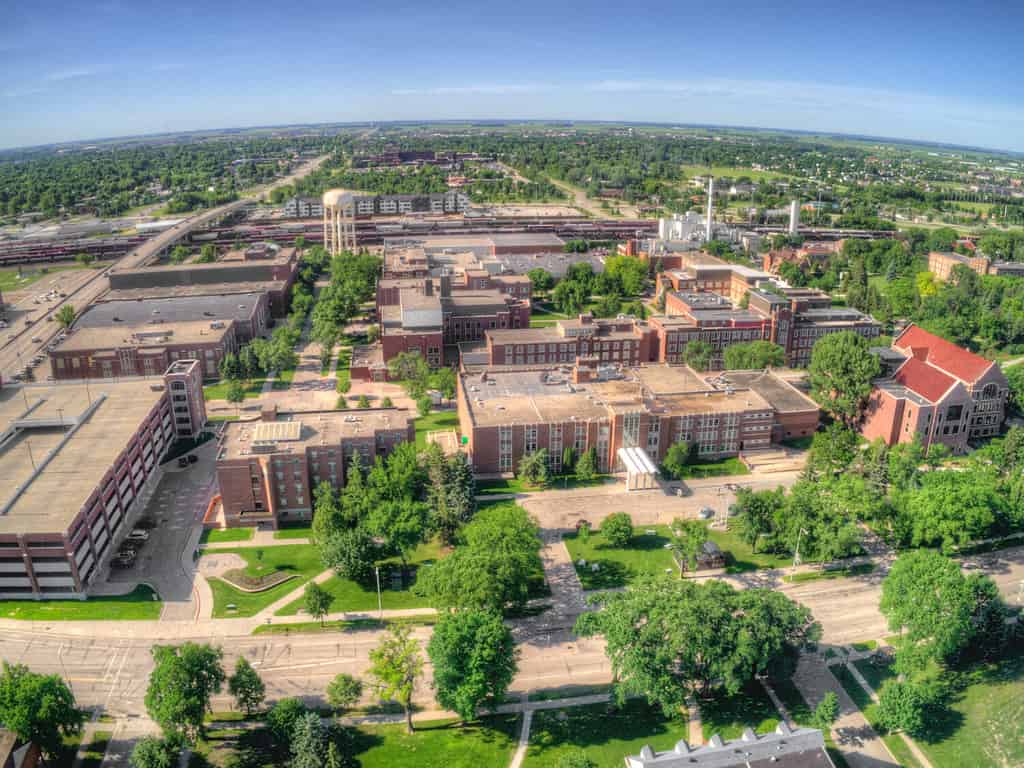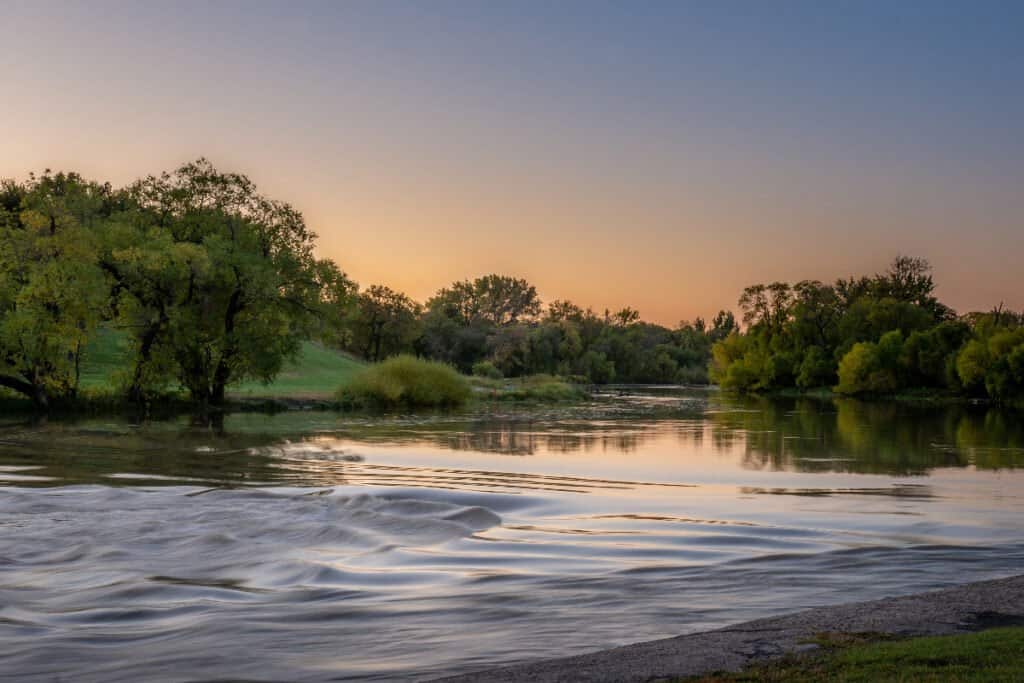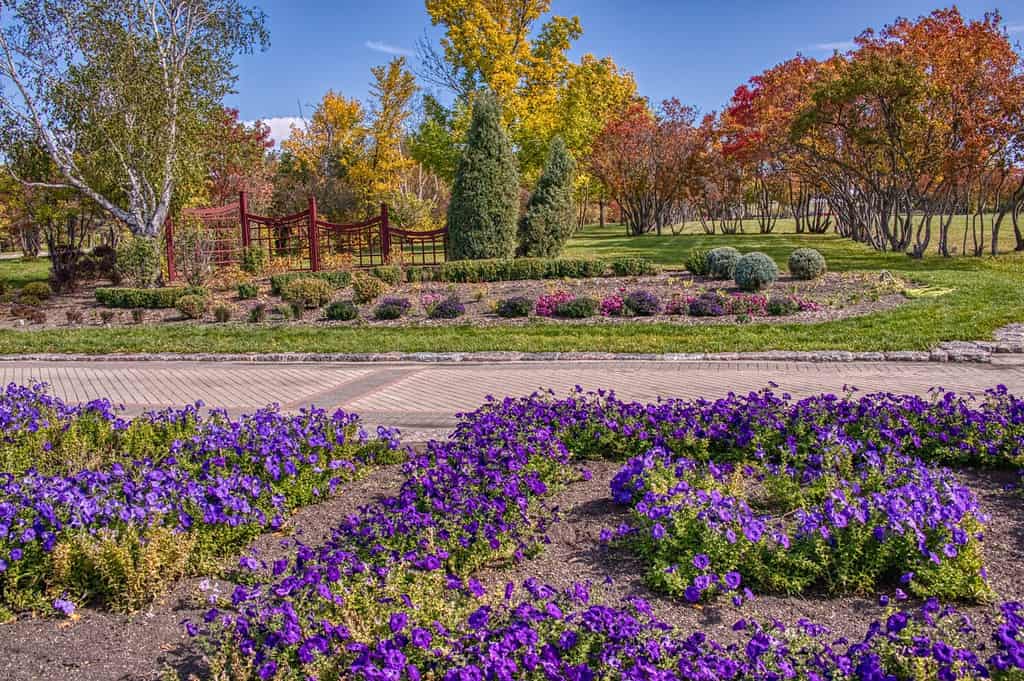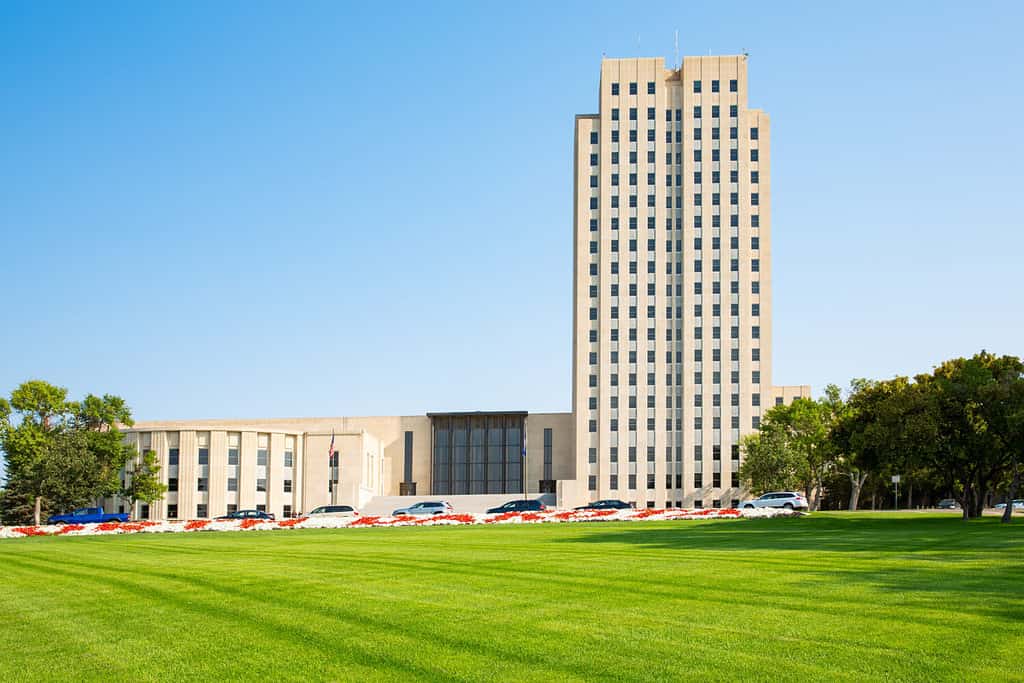
Aerial Drone View of the University of North Dakota in Grand Forks during the Summer
©Jacob Boomsma/Shutterstock.com
Every state in America has a unique and complex history behind them. The state of North Dakota is no different. Many people consider North Dakota as a “fly-by” state going from one side of America to another, however, it’s a state filled with hidden gems. It’s also a peculiar state climate-wise as it’s home to some cacti species and bamboo. This list will provide you with many new things you’ll learn about the state.
1. It’s a very spacious state.
Although North Dakota is the third least populated state in the United States, it’s the nineteenth largest state. The state of North Dakota is made of 70,700 square miles. That means it’s larger than more notable states like Virginia, New York, Georgia, Florida, Ohio, and Maryland. It’s not as large as California and Texas. However, the largest state in America is Alaska.
2. It’s home to the Potato Bowl
The Potato Bowl is an annual week-long festivity that ends with a college football game. They celebrate the state’s most popular crop, the potato. The very first Potato Bowl game was played on September 24, 1966, at the Memorial Stadium. The rivalry started from the two most potato-producing states in America, Idaho and North Dakota.
In September 2023, The Potato Bowl started with a potato chip giveaway and a potato golfing tournament. Then, there was an open baked potato bar. After that, people meet up at University Park for the world’s largest French Fry feed. It consists of well, free French fries courtesy of JR Simplot, a kids’ fun zone, potato sack races, french fry eating contests, and meeting the athletes of the University of North Dakota. Then, the next day is a marathon and swim at a health and fitness center that’s open to all ages. Then the festivities conclude with a parade, tailgating party, and the big Potato Bowl game.
3. It’s home to the snow angel world record.
This state gets plenty of snow and that means there’s a great opportunity to make snow angels. On February 17th, 2002, the state of North Dakota set the world record for most people simultaneously making snow angels. That day, 8,692 people all met at the State Capital grounds and flailed their arms and legs around in the snow. This is not the only world record that North Dakota is known for, however…
4. North Dakota is home to the first person to ever travel to both poles.
Albert P. Crary was a recognized glaciologist and geophysicist. In his lifetime, he became the very first person to travel to BOTH the North Pole and the South Pole. He first hit the North Pole in a Dakota aircraft on May 3rd, 1952. Then, on February 12th, 1961, he visited the South Pole at the McMurdo Station in Antarctica. Albert has a science and engineering center named after him at the McMurdo Station.
5. They have the world’s largest buffalo statue
Jamestown, North Dakota is the home of the world’s largest buffalo statue. This statue is twenty-six feet high, forty-six feet long, and weighs sixty tons. The statue is located at the end of L’Amoure Lane in Jamestown on the top of a hill. This massive sculpture was created by Elmer Petersen. It became one of the best monuments to visit in the Midwest. It received the name “Dakota Thunder” in 2010 from fans of the monument. Live buffalo herds and the Frontier Village are also on site.
6. They also have the world’s largest cow statue.
People can find the world’s largest Holstein Cow known as Salem Sue in New Salem, North Dakota. The world’s largest Holstein Cow is thirty-eight feet tall, fifty feet long, and weighs over six tons. This sculpture is larger than the buffalo mentioned previously in this list. Salem Sue was built in 1974 for forty thousand dollars. The primary purpose of the cow is to honor “the hardworking, persistent, and informed dairyman who is an asset to his community, church, the economy, and his family…” There are brochures and ballads named after the cow that North Dakotans love.
7. It Has The World Record For Largest Scrap Metal Structure
The “Geese In Flight” structure is another animal-like artistic work in the state. It’s located on the Enchanted Highway off of I-94 and Exit 72 in Regent, ND. The “Geese In Flight” stands at one hundred ten feet tall and one hundred feet wide. The “Geese In Flight” statue got the Guinness World Record for the largest scrap metal sculpture in 2002 after it was finished in 2001.
8. The Enchanted Highway & its metal scrap statue collection.
The Enchanted Highway is a famous ND highway that contains a series of metal scrap art sculptures created by Gary Greff. This monumental project was made by a local artist Gary Greff. He drew inspiration from the likes of Theodore Roosevelt amongst other historical figures and the state’s wildlife. Greff sought to use the monuments as a way to revitalize the economic state of his hometown of Regent, North Dakota. It went through many decades of population and economic decline.
The “Geese By Flight” is one of the structures on The Enchanted Highway along with six other pieces of scrap metal art. The other six art figures are “The Tin Family”, “Teddy Rides Again”, “Pheasants On The Prarie”, “Grasshoppers In The Field”, “Deer Crossing” and “Fisherman’s Dream”. There’s another sculpture called “Spider Webs” in the works.
Gary Greff opened a hotel in 2012 called “The Enchanted Castle” to play onto the theme of “The Enchanted Highway” and continue to give back to his hometown. In 2019, the state of North Dakota provided $75,000 to help with the upkeep and maintenance of the enormous structure. Prior to the state’s donation, Greff paid out of his own pocket to sustain the structures. The highway attracts several thousands of travelers annually.
Details About The Metal Structures
“Deer Crossing” is made out of oil well tanks that were cut apart. The “Grasshoppers In The Field” sculpture features many grasshoppers made out of old oil well tanks refused together along with junkyard parts. “Fisherman’s Dream” features a seventy-foot-tall trout circled by many other small fishes. Outside of the seventy-foot tall trout, there are thirty-foot tall fishes that resemble, bluegill, salmon bass, walleye, and catfish.
“Pheasants on the Prairie” is composed of different bird statues. The rooster is forty feet high and seventy feet tall. The hen is thirty-five feet tall and the chicks are fifteen feet tall. These structures are created out of wire mesh.
Teddy Rides Again” is a silhouette of a cowboy on a horse made out of old pipes. It resembles Theodore Roosevelt and his horse Mulley. It stands fifty-one feet tall and weighs over nine thousand pounds. There’s a wooden stagecoach for people to take photos with the pipe-made monument.
On the last stop of The Enchanted Highway is “The Tin Family.” It is helped up by sixteen telephones and was built by used farm equipment such as barbed wire, grain augers, and a five hundred-gallon used farm fuel tank.
Now did The Enchantd Highway solve Regent’s issues as Greff intended? Not exactly. The Regent Elementary School closed down due to declining enrollment and Greff turned it into “The Enchanted Castle” that’s famous today. Prior to COVID, the area improved its tourist numbers.
9. It’s the best state to farm in!
North Dakota is America’s leading producer of sunflowers and honey. The state has plenty of farmland which can cover over twelve million blocks. It also ranks first in producing flax and barley. North Dakota’s farmers produce enough wheat annually to create 12.6 billion loaves of bread, enough beef to make 113 million pounds of hamburger annually, and soybeans to make 483 billion crayons on a yearly basis.
They’re also growing a buffalo meat industry. North Dakota uses ninety percent of its land for agricultural purposes and has over 33,000 farms spanning the state.
Some of the many things that North Dakota produces are beets, barley, wheat, milk, sugar, sunflower seeds, sweet clover, and alfalfa. The wheat crop is the chief crop of the economy as many states get their wheat products from North Dakota.
10. The lowest point in North Dakota is at Red River

Red River is famous for being a saltwater river.
©iStock.com/lakefx
The lowest point is the Red River and it’s between 750 and 950 feet above sea level. It flows into the Manitoba in Pembina. Pembina is in northeastern Dakota and lies on the United States/Canadian border. Many of the early settlers used to travel down the river from Canada into the states for some fur trades with Native Americans.
11. North Dakota is home to the International Peace Garden

This garden is focused on promoting peace and friendship between Canada and the United States.
©Jacob Boomsma/Shutterstock.com
Also located in Manitoba, the International Peace Garden resides along the United States/Canadian border. The garden’s initiative was created by Dr. Henry J. Moore from Ontario, Canada. The goal of the garden is to create friendship between the two countries and their citizens. Fifty thousand individuals traveled to the opening of the garden to celebrate the historical occasion.
One of the more significant features of the garden is a floral clock donated by Bulova in 1964. The concept of the clock comes from the original Bulova Floral Clock in Switzerland. More than 2000 flowers create the 18′ diameter clock.
12. North Dakotans love the serenity in their state.
It’s the least visited state in the United States. However, the less urban environment provides a quiet environment for people. It has a peaceful atmosphere with little traffic.
13. The word “Dakota” comes from the Sioux Tribe.
Before the Europeans took over the land that’s North and South Dakota today, the Sioux Native American tribe used to primarily occupy the area. The Dakota, Nakota, and Lakota tribes used to occupy the Great Plains region. The Great Plains region was composed of both of the Dakotas, Wyoming, Oklahoma, Nebraska, Texas, Montana, Kanas, and Colorado. Once the Europeans inhabited the area, they pushed the tribes into small reservations so they could resume their normal ways of living.
When President James Buchanan signed the Declaration of the Dakota Territory (which was North Dakota, South Dakota, Wyoming, and Montana), he kept the Dakota name in the two states.
14. Bismarck is the second-largest city in North Dakota

Historic State Capitol of North Dakota in Bismarck, USA
©Traveller70/Shutterstock.com
Bismarck, North Dakota is the second largest city in the state only behind Fargo, North Dakota. As of the 2022 US Census, only 125,000 people live in Fargo, North Dakota. 74,400 people live in Bismarck, North Dakota. Bismarck’s original name was Edwinton when it was first founded in 1872. The name comes from Edwin L. Johnson, who played a major part in the Transcontinental Railway. It was renamed Bismarck in 1873 after German Chancellor Otto Van Bismarck in an attempt to get German funding for the railway. Bismarck is realized as one of the stops for the Lewis and Clark expedition and the home of the Dakota Zoo.
15. It was the 39th state admitted into the United States.
North Dakota officially became a state in 1889. It was the 39th state and South Dakota became the 40th state. How did that come to be? President Benjamin Harrison shuffled the declaration papers around and signed them without knowing which upcoming state territory was first to be signed.
16. North Dakota is home to the inventor of the camera.
David Henderson Houston was a Canadian-born resident who came to America as an adult and lived as a farmer. He filed his first of many patents in 1881. That of which was the camera itself. The patent for the camera film roll came in 1885. Houston influenced another inventor, George Eastman, to choose the name for the Kodak camera. The original spelling of the name was Nodak, after the fresh inauguration of North Dakota, but the K was added so the brand’s name can be very recognizable.
17. The oldest town in North Dakota is in Pembina
Pembina, North Dakota is the oldest town in the state of North Dakota. Pembina is located in the northeast section of North Dakota near the state of Minnesota and the United States/Canadian border. The Red River, which contributes to the agriculture of the state, runs through the city. It’s near the Pembina/Emerson border which is one of three border sites that are open 24/7.
The earliest history of Pembina was recorded in 1797. It was a trading post under the name Port Fanbain. The addition of the permanent trading post established the new history of the town. Prior to that, the area was inhabited by different Native American tribes. Charles Baptiste Chaboillez established Port Fanbain. Chaboillez worked for the Hudson Bay Company as a trader. The area turned into Fort Pembina in the American Civil War. Later in the decade, Fort Pembina grew as a major trading spot for the Americans and Canadians.
The wildlife in Pembina is a diverse one. People can find beaver, moose, and bison across the plains and the banks of The Red River. One place people can learn more about the history of Pembina is the Pembina State Museum. Pembina is also a popular church city with many different practices. So if people want to learn more about different religions, they have many historic churches available to visit.
Thank you for reading! Have some feedback for us? Contact the AZ Animals editorial team.








